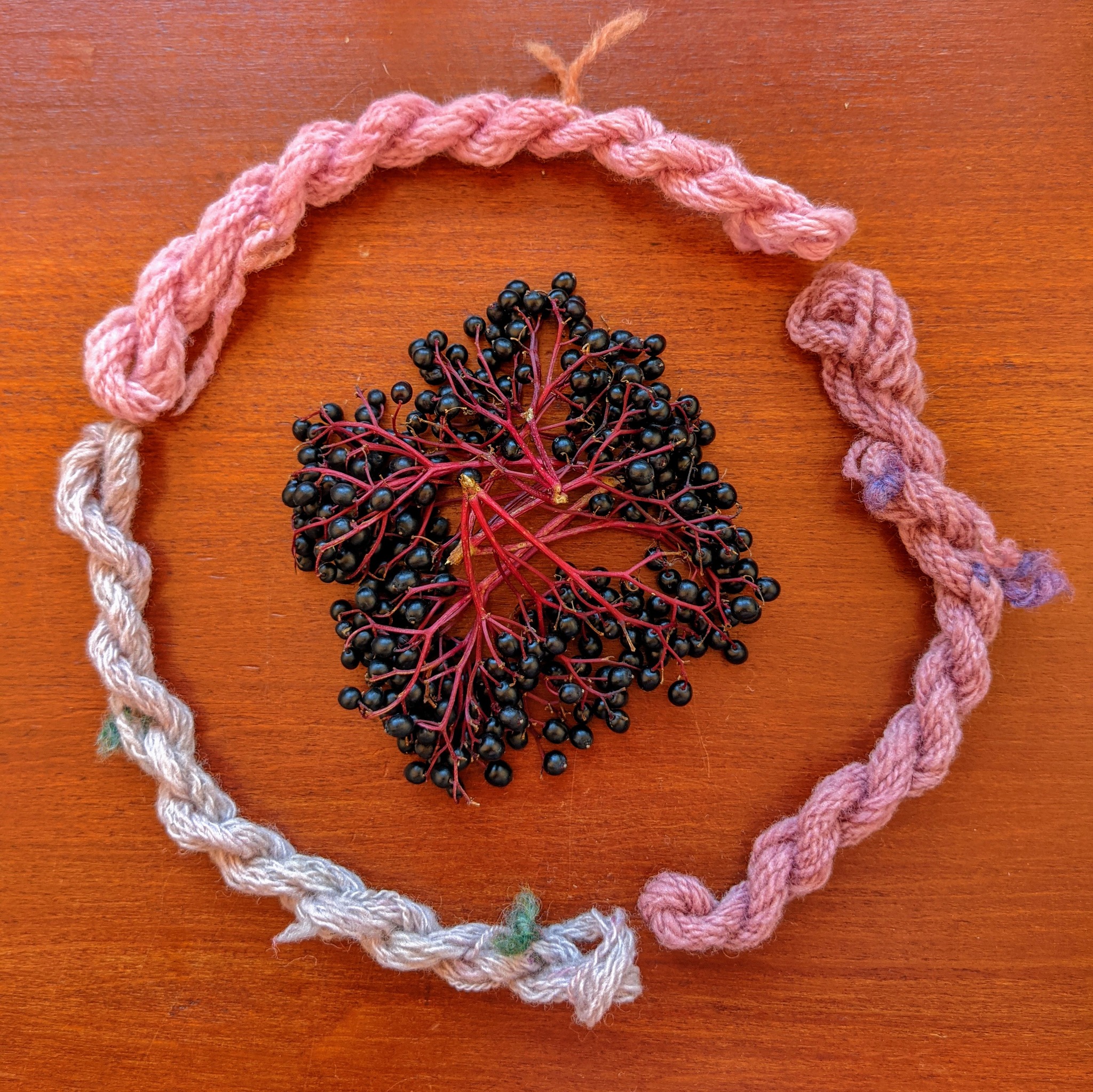Anyone who has ever picked elderberries before will know that they stain your hands a beautiful purple colour. But could this common berry be used for dyeing yarn, and would that colour stand the test of time?
After a foraging foray in October 2023, I decided to reserve some elderberries for a dyeing experiment. Traditional Scottish Dyes by Jean Fraser describes blues, violets, and purples that can be obtained with the berries. Unfortunately, berries are notorious for giving lovely colours that soon fade away.
The Science of Dyeing
Dyes are coloured compounds that chemically attach to fibres. There are lots of different types of dyes, both natural and synthetic. I used the elderberries as a mordant dye, meaning metal salts were attached to the fibres before dyeing. During dyeing the mordant forms a complex with the dye, attaching the dye strongly to the fibre. This makes mordant dyed fibres less likely to lose their colour over time than textiles dyed without these metallic salts.
Lightfastness is the resistance of a dye to fading when exposed to light. Without getting too technical, the energy from light causes the dye molecules to change. This results in colour changes, often a fading of colour. In my experiment, I tested the lightfastness of elderberry dye without mordants, with aluminium sulphate, and alum with ferrous sulphate.
Dyeing
I dyed three samples with different methods to see how the mordants would affect the colours given and their fastness. I used the elderberry dye on handspun merino wool. Sample 1 was left unmordanted as a control to see how the berries and light affected the wool without any other influences. Sample 2 and 3 were both mordanted with aluminium sulphate and cream of tartar. I used the mordant recipes in Traditional Scottish Dyes, which recommends a ratio of 3 ounces of alum to 1 pound of fine wool and 1 ounce of cream of tartar to 4 ounces of alum.
I used a ratio of 2:1 berries to wool by weight. The elderberries were placed in three glass jars and crushed a bit to open them up. I added cool water and a small skein of wool to each jar. I added some ferrous sulphate (iron) mordant into Sample 3 until I could see a colour change. Each jar was then placed in a water bath, which was heated to simmering. The skeins simmered for 90 minutes and were allowed to cool.
Once cool enough to handle, they were rinsed in cool water to remove the elderberry bits and excess dye. Unfortunately, after rinsing they already looked duller. Often textiles will appear a different colour when wet, so it’s unclear if this colour change was because they were dry or due to dye lost during washing.

Sample 1, the unmordanted skein (right in photo), dyed a dusty purple/mauve colour. Sample 2, the aluminium sulphate mordant (top in photo), dyed pink. Sample 3, the aluminium and iron mordant (left in photo), dyed dusty blue. My personal favourite was the unmordanted skein.
Light Fastness Test
But now to put the dyes to the test! I knit each of the yarns into a small swatch and covered half with a thick gray fabric. The fabric prevented the covered half from being exposed to sunlight. The samples were then placed in a window for six months.

After the time had elapsed, I took the samples down and removed the fabric. Now I could clearly compare the original colours to the faded ones.
Results
As expected, exposure to sunlight drastically changed all the samples.

In the photo, the top half of each sample was covered to protect it from light. You can see a distinct line separating the light exposed areas from the sections that were covered. The dyes of the alum and unmordanted samples faded quite a lot. However, the sample dyed with iron actually got darker! I was surprised by this result and triple checked that I hadn’t flipped the sample. Exposure to light changes dye molecules. Usually this causes the dyes to lighten, but in this case the colour became darker and more yellow. Light had still changed the elderberry with iron dye, just differently than the other samples.
Conclusions
As a textile conservator, I care a lot about the lightfastness of the dyes I use. Personally, I don’t think I’ll be using elderberry as a dye in the future. Knowing that the lovely pinks and purples will soon fade would discourage me from actually using any textiles dyed with elderberries.
However, most textiles aren’t hung in a window for six months. The fading caused by light would likely be less during the regular use of a garment. One thing to note though is that this experiment only tested lightfastness, not washfastness. Washing a garment dyed with elderberries would also speed up the loss of colour. However, if that doesn’t bother you, you’re welcome to try dyeing with elderberries yourself!
If you’re interested in learning more about natural dyeing, check out my article on dyeing with Lady’s Bedstraw!
